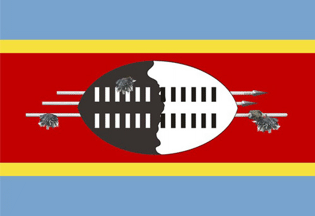![[Swaziland]](../images/s/sz.gif) image by António Martíns-Tuválkin, 01 May 2016
image by António Martíns-Tuválkin, 01 May 2016
Last modified: 2019-05-09 by bruce berry
Keywords: swaziland | eswatini | elephant | ngwane |
Links: FOTW homepage |
search |
disclaimer and copyright |
write us |
mirrors
 Image
sent by Ralph Kelly, 21 Apr 2019
Image
sent by Ralph Kelly, 21 Apr 2019
![[Swaziland]](../images/s/sz.gif) image by António Martíns-Tuválkin, 01 May 2016
image by António Martíns-Tuválkin, 01 May 2016
The flag is rectangular, and its colours are red, blue and yellow. Each
of these colours has a specific meaning, namely:
Red stands for the battles of the past
Blue stands for peace and stability
Yellow stands for the natural resources the country possesses.
The flag also has a picture of a shield and spear. These two symbols
stand for protection of the country from enemies. The shield is black and
white to show that black and white people live together peacefully in eSwatini (Swaziland).
Source: this
website.
The flag was officially hoisted on 30 October 1967. It
is based on the
flag, granted by King Sobhuza II to the Emasotsha Regiment in 1941. This
flag, amended slightly, was hoisted on 25 April 1967 when the British
Union flag used during the colonial period was hauled down. The blood red color is the symbol of past struggles;
yellow points at prosperity by the richness in minerals; blue is the colour
of peace.
Source: Pedersen, "Moussault's Lexicon van vlaggen en wapens",
1980 [ped80].
The flag hoisted for the first time on 25 April 1967 on the occasion of the pledge
of the oath by King Sobhuza II. After its registration with the College of Arms
in London
on 30 October 1967, it was was adopted in a slightly different form. The
flag is based on the flag
granted by the King to the Swazi Pioneer Corps during the Second World War in 1941.
The Swazi ox hide-shield belongs to the Emasotsha Regiment.
Source: Rabbow, "DTV-lexikon politischer Symbole",
1970 [rab70].
Jarig Bakker, 02 Mar 2001
According to an official (undated) Government leaflet entitled "The Swaziland
Flag", the significance of the flag is as follows:
"The Swaziland flag, based on the royal standard woven nearly 30 years ago, has
now been registered at The College of Arms in London. The Garter of Arms
and The Windsor Herald Registrar submitted, on 30 Oct 1967, a final exact design
which received the approval of HM King Sobhuza II.
The flag's specifications
are briefly as follows:
a) A rectangle with sides in the proportion 3 to 2.
b) Five horizontal bars in the proportion, vertically, of 3 mid-blue, 1 yellow,
8 crimson, 1 yellow and 3 mid-blue.
c) On the wide crimson bar, a black and white Swazi
shield of the Emasotsha regiment, in a sideways position, as when carried
walking. The black portion of the shield is towards the hoist (flagpole)
and the decoration injobo-feathers of the lisakabuli (widow bird)
and ligwalagwala (lourie bird) hangs from the upper portion of the black.
This particular injobo is used only by the King.
d) Behind the shield are two spears (tikhali) and a staff (umgobo)
with tassels (also royal tinjobo). The spears point towards the fly, away
from the flagpole, and are above the stick. All three of these
accoutrements lie horizontally. They are in their natural colours.
e) The colours are in accordance with those laid down by the British Admiralty
and their numbers on the Admiralty Chart are as follows:
Black T811
White T819
Crimson T816
Yellow T820
Blue
T813
On the flag, crimson stands for battles of the past, yellow represents
the wealth of the resources the country possesses, and the blue signifies peace".
Bruce Berry, 17 Apr 2003
National Flag. -SW/--- 2:3
The construction details for the stripes are given as 3+1+8+1+3. Colours are
approximated to darker shades than illustrated above. Pantone approximations are
given in Album as:
blue 293c
yellow 116
red 201c
Željko Heimer, 01 Feb 2003
I only have a partial text of Act No. 36 of 1968 which established the flag. It does confirm the stripes as 3 mid-blue, 1 yellow, 8 crimson, 1 yellow, 3 mid-blue. These were originally regulated according to the now redundant British Admiralty System as: Black T11, White T819, Crimson T816, Yellow T820 and Blue R813.
According to the official model I have on file, the Pantone colours
given in the Album are too dark (and the
ones illustrated on FOTW too light).
Civil use of the flag: The text I have makes no reference whatever
to civil use of the flag (or otherwise).
Christopher Southworth, 01 Feb 2003
The protocol manual for the London 2012 Olympics
(Flags and Anthems Manual, London, 2012 [bib-lna.html])
provides recommendations for national flag designs. Each National Olympic
Committee was sent an image of their flag, including the PMS shades, by the
London Organising Committee of the Olympic Games (LOCOG) for their approval.
Once this was obtained, the LOCOG produced a 60 x 90 cm version of the flag for
further approval. So, while these specifications may not be the official,
government, version of each flag, they are certainly what the National Olympic
Committee believed their flag to be.
For Swaziland : PMS 638 blue, 102 yellow, 199 pink, 430 grey, 491 brown and
black. The vertical flag is simply the horizontal version turned 90 degrees
clockwise.
Ian Sumner,
10 Oct 2012
![[Swaziland Coat of Arms]](../images/s/sz).jpg) image from Ralf Hartemink's
website.
image from Ralf Hartemink's
website.
The National Arms
The two supporters are the symbols of power for the King (lion) and
the Queen-mother (elephant). The shield is a typical Nguni shield used
in the country. The weapons on the shield are typical local weapons. The colour of the shield is derived from the King's own regiment. Siyinqaba
means: We are the fortress "We are a tower of strength".
Ralf Hartemink, 14 Jan 2002